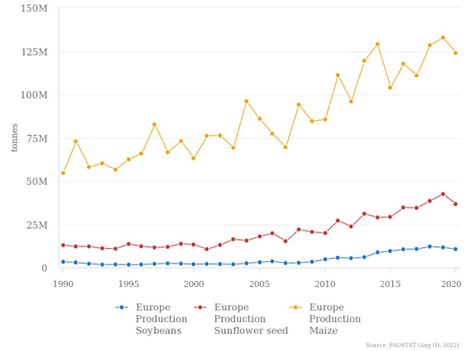SOURCE:
A search of Google news for the phrase “climate change,” today turns up a story in Trade Finance Global (TFG) which claims climate change is harming key European crops, exacerbating a food crisis created by Russia’s invasion of Ukraine.
This claim is wrong. In the story, TFG made the all too common, yet scientifically unjustifiable, mistake of conflating a single season’s suboptimal weather with long-term climate change. Data shows over the past 30 years, the period over which climate change is measured, each of the crops discussed in the TFG article have increased dramatically.
In the article titled, “‘Heatflation’ warning as 2022 EU crop harvests affected by climate change,” TFG reporter Lisa Mendes writes:
As much of Europe bakes in the latest heatwave, fears are growing about what’s being dubbed ‘heatflation’ – climate change-driven staple crop losses that could see already inflated food prices reach new highs this autumn, deepening the cost-of-living crisis.
A lack of spring rainfall, combined with drought and freak storms, have spoiled crops in Italy, France, and Spain, with many farmers and agricultural associations warning that this year’s continental crop yields will be significantly smaller than usual.
Already, continental yields of crops such as soybean, sunflower, and maize were 9 percent below average, according to an EU bulletin published last month.
Attributing a single year’s weather events and crop declines to climate change is illegitimate. As explained in numerous previous Climate Realism posts, here and here, for example, weather is not climate.
The National Oceanic and Atmospheric Administration clearly defines weather as “[R]eflect[ing] short-term conditions of the atmosphere while climate is the average daily weather for an extended period of time at a certain location. … Weather can change from minute-to-minute, hour-to-hour, day-to-day, and season-to-season.”
The standard period for recognizing a change in climate is an average change or trend in conditions for a location or region of 30 years or more, as defined by the World Meteorological Organization.
There has been no consistent trend or change in Europe’s climate over the past 30 years. Also, although farmers may be reporting below average production for the crops discussed in the TFG article this year, as history shows, and as any long-time farmer or farm family could tell Mendes if she had asked, it is common for crop production to wax and wane along with variable weather conditions from year to year. A single down year for crop production is not evidence of climate change.
Data from the U.N. Food and Agriculture Organization undermine any claim that climate change has negatively impacted the production of corn (maize), soybeans, or sunflowers across Europe amid modest warming since 1990. FAO’s crop tracker finds for Europe, between 1990 and 2020:
- Maize production increased by more than 127 percent;
- Soybean production grew by more than 218 percent;
- Sunflower production expanded by more than 184 percent. (see the figure below)

Europe is suffering under a heatwave and associated drought. However, such events have been common throughout the continent’s history. A single year of hot, dry weather conditions does not constitute proof of climate change, nor does a single year’s crop decline. Weather and crop production are both notoriously fickle, as Mendes and TFG should know. Real world data indicate long term weather conditions have not significantly changed across Europe, and crop production has, in fact, increased. The idea that climate change is causing “staple crop losses” is just false.